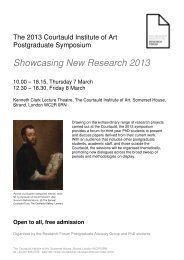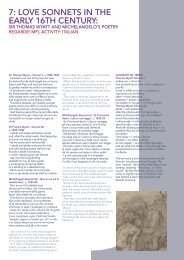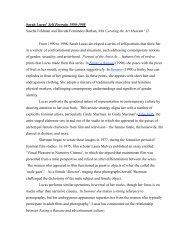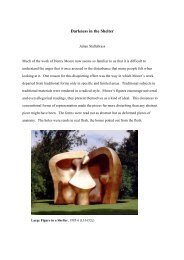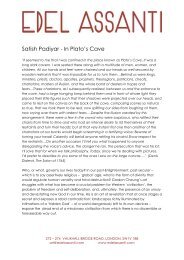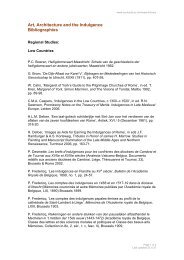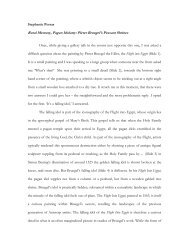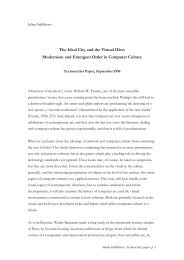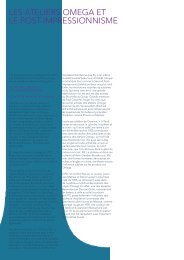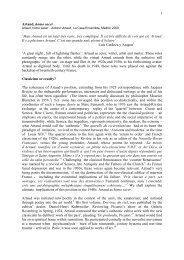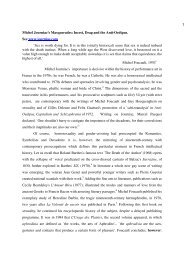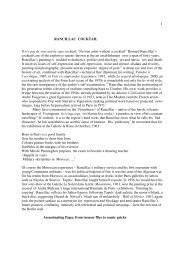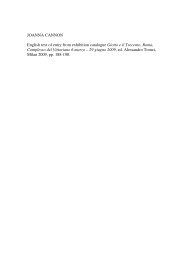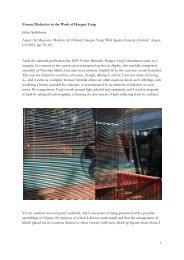Myriam Bat-Yosef and Performance - The Courtauld Institute of Art
Myriam Bat-Yosef and Performance - The Courtauld Institute of Art
Myriam Bat-Yosef and Performance - The Courtauld Institute of Art
You also want an ePaper? Increase the reach of your titles
YUMPU automatically turns print PDFs into web optimized ePapers that Google loves.
Rites <strong>of</strong> Passage: <strong>Myriam</strong> <strong>Bat</strong>-<strong>Yosef</strong> <strong>and</strong> <strong>Performance</strong><br />
From Éryximaque 1965, to My Will 1990, <strong>Myriam</strong> <strong>Bat</strong>-<strong>Yosef</strong>'s performance<br />
works demonstrate continuity <strong>and</strong> a perpetual challenge: she questions the binaries <strong>of</strong><br />
male <strong>and</strong> female, animate <strong>and</strong> inanimate, life, death <strong>and</strong> procreation. Entering or leaving<br />
her studio near the Place d'Italie we are caught in a painted mirror inscribed<br />
DUELOGUE…. Informed by readings <strong>of</strong> the kabbalah <strong>and</strong> the wisdom <strong>of</strong> Tao, these<br />
binaries are constantly antagonistic, seldom resolved. Past the mirror, a small canvas<br />
depicts a crouching adolescent girl, naked, vulnerable, ashamed: After <strong>of</strong> 1951. She hides<br />
her face. Within the span <strong>of</strong> two decades, the spaces <strong>of</strong> clashing continents <strong>and</strong> cultures,<br />
this body would become hybrid, performative, confident <strong>and</strong> free. <strong>Bat</strong>-<strong>Yosef</strong>'s<br />
performance works <strong>of</strong>fer a new reading <strong>of</strong> her myriad-coloured objects <strong>and</strong> body-part<br />
sculptures: stemming from an evidently surrrealist merveilleux they become powerful<br />
witnesses to events <strong>and</strong> movements <strong>of</strong> the past, both fetishes <strong>and</strong> témoins - witnesses -<br />
expressing a longing for a wholeness that invites complex forms <strong>of</strong> response.<br />
Who is this Marion Hellerman, Mimi, <strong>Myriam</strong> Gudmunsson, <strong>Myriam</strong><br />
Josefsdottir, <strong>Myriam</strong> <strong>Bat</strong>-<strong>Yosef</strong>, `daughter <strong>of</strong> <strong>Yosef</strong>'? A child <strong>of</strong> Berlin, a young Israeli<br />
female soldier, a Parisian Beaux-<strong>Art</strong>s student, an artist working internationally in the<br />
1960s <strong>and</strong> 1970s, an Icel<strong>and</strong>ic feminist heroine: all <strong>of</strong> these?<br />
Si dieu est un cerf-volant<br />
Qui diable est George S<strong>and</strong>? 1<br />
<strong>The</strong> questioning <strong>of</strong> surrealist poet Joyce Mansour raises another issue <strong>of</strong> naming; the fact<br />
that for Claude Cahun, Prinner, Toyen, Axell, ambiguous names declare the politics <strong>of</strong><br />
the `story <strong>of</strong> art' . <strong>Bat</strong>-<strong>Yosef</strong>'s story engages both with the problematics <strong>of</strong> the female<br />
artist who transcends the role <strong>of</strong> muse or model, <strong>and</strong> that <strong>of</strong> the three twentieth-century<br />
generations <strong>of</strong> the School <strong>of</strong> Paris: emigrants attracted to the intellectual <strong>and</strong> artistic life<br />
<strong>of</strong> the French capital, so many <strong>of</strong> whom changed their names as they started new lives. It<br />
is a long story <strong>of</strong> w<strong>and</strong>ering, belonging <strong>and</strong> not belonging. <strong>The</strong> archetypal `nomadic<br />
subject' has been linked structurally to a feminism which `struggles to change the value<br />
attributed to <strong>and</strong> the representations made <strong>of</strong> women in the longer historical time <strong>of</strong><br />
patriachal history… as well as in the deeper time <strong>of</strong> one's own identity' 2<br />
When, as a student, <strong>Myriam</strong> <strong>Bat</strong>-<strong>Yosef</strong> arrived in Paris, her painting was<br />
conservative: a post-Cézannism <strong>of</strong> l<strong>and</strong>scapes <strong>and</strong> portraits with a hint <strong>of</strong> Kokoschka,<br />
corresponding to the teaching <strong>of</strong> her masters in Israel; she would not modify her style<br />
under the aging authority figures at the Ecole des Beaux-<strong>Art</strong>s. It is interesting that<br />
Avigdor Arikha, who came to her first solo show at the Club Israélien in 1955, would<br />
persist in traditional figurative genres, ultimately accomplishing an old-master-like<br />
facture which has served him well. 3 <strong>Bat</strong>-<strong>Yosef</strong> <strong>and</strong> Arikha bore secret scars <strong>of</strong> trauma<br />
<strong>and</strong> loss at the time, linking them to so many precursors <strong>of</strong> the prewar School <strong>of</strong> Paris. In<br />
1951, the veteran painter Marc Chagall, prefaced Hersch Fenster's Undzere farpainikte<br />
Kinstler (Our martyred painters) which recounted, in Yiddish, the biographies <strong>of</strong> Jewish<br />
artists from France <strong>and</strong> their experiences through the holocaust period. 4 Significantly <strong>Bat</strong>-<br />
<strong>Yosef</strong>, fatherless <strong>and</strong> with no family in Paris, was regularly invited to the house <strong>of</strong> the<br />
philosopher Emmanuel Levinas for the sacred Friday-evening meal which heralds the<br />
sabbath.<br />
1
Even in Florence, under the spell <strong>of</strong> Siennese madonnas, her elongated selfportrait<br />
set against a stacked, rocky l<strong>and</strong>scape was marked with the Star <strong>of</strong> David, `my<br />
Jewish destiny'. A feeling <strong>of</strong> isolation distinguishes it sharply from the integrated gold<br />
<strong>and</strong> blue world <strong>of</strong> beliefs, worship <strong>and</strong> gothic craftsmanship which was its source. 5 But<br />
then in 1955 came the December masked ball, the encounter with Ferro, painter-Viking<br />
<strong>and</strong> a magical trip round Italy on a Vespa. <strong>Myriam</strong>'s first Venice Biennale in 1956 was a<br />
revelation: she discovered the international art world in the company <strong>of</strong> Ferro <strong>and</strong> Jean-<br />
Jacques Lebel, meeting the critic Alain Jouffroy <strong>and</strong> veteran surrealist Roberto Matta<br />
among others. How exhilarating for the couple Ferro <strong>and</strong> <strong>Bat</strong>-<strong>Yosef</strong> to have joint solo<br />
shows in Rome so quickly, both acknowledged by none other than Lionello Venturi! <strong>The</strong><br />
Icel<strong>and</strong>ic saga began for her as she followed Ferro to his home country. A greater<br />
abstraction in her work responded to the impact <strong>of</strong> the dramatic l<strong>and</strong>scape <strong>and</strong> dazzling<br />
Northern lights, surely involving a recognition <strong>of</strong> the Northern dimensions <strong>of</strong> her own<br />
origins… Reciprocally, <strong>Bat</strong>-<strong>Yosef</strong> would show Ferro her adopted country, Israel, where<br />
he exhibited at the important museums in Bezalael, Tel-Aviv <strong>and</strong> Haifa in 1958: what an<br />
exchange for these citizens <strong>of</strong> the world, on the brink <strong>of</strong> the 1960s!<br />
Femmes surréalistes: the encounter with EROS<br />
It was a deepening encounter with surrealism back in Paris, however, that would<br />
change <strong>Myriam</strong>'s work <strong>and</strong> lead to performances: how ironic that only much later would<br />
she befriend Hélène Vanel, whose L'Acte manqué - Unconsummated act was danced in<br />
the `hysterical bedroom' created for the International exhibition <strong>of</strong> Surrealism in 1938.<br />
This pioneer female performance ranks with the dances <strong>of</strong> Mary Wigman, Isidora<br />
Duncan or Valentine de Saint Point, another great female precursor who astonishingly<br />
awaits her deserved place in France's artistic pantheon.<br />
<strong>The</strong> male dominance perceived as entirely natural in the 1950s art world is<br />
almost unimaginable today. 6 Yet in one territory, surrealism, la femme had always been<br />
accorded a special place as muse, even creator. <strong>Myriam</strong>'s engagement coincided with its<br />
second wave <strong>of</strong> erotic intensity. Returning from Israel with Ferro in autumn 1958 she<br />
reconnected to the surrealist world via Jean-Jacques Lebel. Ferro recollects that Joyce<br />
Mansour, the poet <strong>of</strong> female desire, <strong>of</strong> Cris <strong>and</strong> Déchirures, accompanied André Breton<br />
to their joint studio. 7 Ferro's `apocalyptic' period was tending increasingly to the<br />
mechanomorphic, his immense energies producing terrifying metaphors for the atomic<br />
age… It is not surprising, therefore, that Breton, was more drawn along with his<br />
complice to <strong>Myriam</strong>'s work which blossomed in this radiant period <strong>of</strong> her pregnancy.<br />
Surrealism <strong>of</strong> the late 1950s was penetrated by a new <strong>and</strong> strange species <strong>of</strong><br />
woman. From amour courtois to amour fou: the boundaries protecting the terrains <strong>of</strong> the<br />
male surrealist poets <strong>and</strong> painters were dissolving, this time through the automatisms not<br />
<strong>of</strong> a Masson or a Miro but those <strong>of</strong> Toyen, Bona or Unica Zürn who took part in the<br />
Exposition inteRnatiOnale du Surréalisme (EROS) at the Galerie Daniel Cordier in<br />
1959. Proclaiming female subjectivity, desire, frustration <strong>and</strong> rage their work could be<br />
vengefully phallic or could deploy the destabilising tropes <strong>of</strong> madness. <strong>The</strong> relationship<br />
between `schizophrenic' productions by Alöyse, for example, <strong>and</strong> the works <strong>of</strong> a<br />
Leonora Carrington or a Zürn (both <strong>of</strong> whom were close to psychiatric institutions <strong>and</strong><br />
their practices) was a distinguishing feature <strong>of</strong> the `Eros' show, as was its performative<br />
2
aspect: the `interior <strong>of</strong> the body' environment resounding with François Dufrene's<br />
fractured languages: a pulsating sound-score for the show which anticipated his<br />
collaboration with <strong>Bat</strong>-<strong>Yosef</strong>.<br />
This veritable universe <strong>of</strong> female creators (strongly featured in Breton's new<br />
journal, Le Surréalisme Même) now welcomed <strong>Myriam</strong> <strong>Bat</strong>-<strong>Yosef</strong>, though she would<br />
never wish to join what Leonor Fini sardonically called `the Group'. 8 Manina, wife <strong>of</strong><br />
critic Alain Jouffroy, <strong>and</strong> above all Bona, wife <strong>of</strong> the poet André Pieyre de M<strong>and</strong>iargues<br />
would become close friends, as would Unica Zürn - like <strong>Myriam</strong>, born in Berlin. Zürn's<br />
linguistic anagrams in their rapport with the tangled female limbs <strong>of</strong> Hans Bellmer's<br />
drawings, may be seen as fascinating precursors to <strong>Bat</strong>-<strong>Yosef</strong>'s Érixymaque. 9<br />
<strong>The</strong> Sadean heritage <strong>of</strong> surrealism was transformed at this time under the<br />
aegis <strong>of</strong> Henri Alleg's La Question - the moral <strong>and</strong> political question <strong>of</strong> torture in<br />
Algeria. 10 <strong>Art</strong> became ever more violent, notably in the now-celebrated history painting<br />
Le Gr<strong>and</strong> Tableau antifasciste, produced by Lebel, Ferro, Crippa, Baj, Dova <strong>and</strong><br />
Recalcati in Milan in 1960: `Bodies ripped apart, mainly women, blood, entrails, eyes<br />
squeezed out <strong>of</strong> their sockets everywhere, lots <strong>of</strong> heads, lots <strong>of</strong> mouths screaming or<br />
stuffed with information.' 11 Deliberately blasphemous, denunciatory, the work<br />
nonetheless expresses a paroxysm <strong>of</strong> masculine painterly jouissance.<strong>The</strong> message was<br />
hardly feminist. Nor were the accompanying happenings <strong>and</strong> performances (genres<br />
introduced by Lebel to France): Lebel as De Gaulle in a rubber mask pushing a pram;<br />
Ferro as `sex-priest' dipping a papier-mâché penis into pots <strong>of</strong> paint held between the thighs<br />
<strong>of</strong> two women; two naked women, wearing Khruschev <strong>and</strong> Kennedy masks, strangling each<br />
other in a bath <strong>of</strong> `blood'. 12 In May 1964 at the American Center's Festival <strong>of</strong> Free<br />
Expression (where <strong>Bat</strong>-<strong>Yosef</strong> also exhibited) Ferro with a tank <strong>of</strong> coloured water on his<br />
back peed his `golden shower' through a metal pipe into various female mouths (Gold<br />
Water, an anti-Vietnam happening, focussed on the right-wing republican Barry Goldwater).<br />
Simulated sex acts, feminisation, were metaphors - then as now - for political humiliation,<br />
abjection. An alternative, egalitarian work, Carolee Schneeman's Meat Joy <strong>of</strong>fered a<br />
different paradigm: a staged mélange <strong>of</strong> naked bodies, `sensual, comic, joyous, repellent'. 13<br />
Ferro had played voyeur <strong>and</strong> accomplice for Schneeman's pioneer Eye body series which he<br />
photographed in New York: `Covered in paint, grease, chalk, ropes, plastic' Schneeman<br />
established her body as visual territory… 14 1964 would mark a period <strong>of</strong> betrayal <strong>and</strong><br />
pain for <strong>Bat</strong>-<strong>Yosef</strong>, culminating in divorce; but it would herald her liberation.<br />
Éryximaque: diabolo dance<br />
Mais mon désir est mouvement, Éryximaque,<br />
(Socrates in Paul Valéry, L'Ame et la danse)<br />
So Éryximaque was not born in a vacuum. <strong>Bat</strong>-<strong>Yosef</strong> would refute the passive, sexual<br />
position <strong>of</strong> horizontality, the abjection <strong>of</strong> smeared liquids, <strong>and</strong> the voyeurisitic male-onfemale<br />
gaze implied in Schneeman's Eye Body, releasing the body into movement,<br />
colour, action <strong>and</strong> a freedom linked with a certain <strong>and</strong>rogeny. Éryximaque, the heroine<br />
<strong>of</strong> Paul Valéry's `Socratic' dialogue <strong>of</strong> 1921, would now be reborn as the spirit <strong>of</strong> 1960's<br />
liberation. 15 Éryximaque, a collaboration between <strong>Bat</strong>-<strong>Yosef</strong> as conceptor, costume maker<br />
3
<strong>and</strong> painter <strong>of</strong> objects, Teresa Trujillo, a dancer from Uruguay, <strong>and</strong> the concrete poet,<br />
François Dufrêne, was performed four times in two venues at the Paris Biennale <strong>of</strong> 1965. 16<br />
<strong>Bat</strong>-<strong>Yosef</strong> chose Éryximaque's performance space - Objet (zone blanche) - a<br />
collaborative work by Markus Rätz's, Andreas Christen <strong>and</strong> Willy Weber: Switzerl<strong>and</strong>'s<br />
contribution to the Biennale. Three high white walls, were arranged in a triangle, with gaps<br />
for entrance <strong>and</strong> exit at each point, in a space with a white floor. This `white zone', textured<br />
with wall-reliefs, claimed the heritages <strong>of</strong> neoplasticism <strong>and</strong> the monochrome as well as a<br />
specifically Swiss modernism <strong>and</strong> spirituality. It <strong>of</strong>fered a perfect space for dance <strong>and</strong><br />
sound, with spectators st<strong>and</strong>ing at each open angle. 17<br />
Already <strong>Bat</strong>-<strong>Yosef</strong> had extended her practice to the painting <strong>of</strong> objects: Table de<br />
nuit was exhibited with thirty-eight exquisite works on paper in her first major Paris show<br />
at the Galerie Garnelle in 1964. She had discovered diabolo-shaped, heavy wooden stools<br />
designed by Nana Dietzel in the Maison du Danemark, On seeing these, Trujillo desired to<br />
dance with them; <strong>Myriam</strong>'s idea was to extend their painted surfaces to that <strong>of</strong> the dancer<br />
herself: a confusion <strong>of</strong> body <strong>and</strong> object would take place via both movement <strong>and</strong> rhythm.<br />
Trujillo danced inside Objet (zone blanche), her body painted all-over in a multi-coloured<br />
design <strong>of</strong> flaming organic shapes, like a latter-day Nijinsksy faun, body-costumed by Bakst.<br />
Dancing with, on <strong>and</strong> around the stools which supported <strong>and</strong> extended her body, throwing<br />
<strong>and</strong> receiving them as they rolled back <strong>of</strong>f the walls <strong>of</strong> the white environment, she realised<br />
the <strong>and</strong>rogynous ideal: an ideal central to René de Solier's superb text on <strong>Myriam</strong>'s work as<br />
an oneiric universe. 18 Vision as well as gender became bewildered as objects <strong>and</strong> bodies<br />
fused.<br />
Yet the dialogical other for Érixymaque was not to be found in the American<br />
Center's daring happenings at all: rather in the iconic performances <strong>of</strong> Yves Klein.<br />
<strong>Myriam</strong> <strong>Bat</strong>-<strong>Yosef</strong> recalls her repugnance at seeing a performance by Klein at the<br />
Musée d'<strong>Art</strong> Moderne de la Ville de Paris: the helpless passivity <strong>of</strong> the models, smeared<br />
in blue paint, as they following the master's directions. 19 Klein's now celebrated work<br />
with these femmes-pinceaux (`female paintbrushes') - a brilliantly ironic parody <strong>of</strong> the<br />
artist-model relationship in the era <strong>of</strong> striptease - was instantly parodied. 20 <strong>Myriam</strong> recalls<br />
Guatterio Jacopetti's cruel use <strong>of</strong> Klein's footage in Mondo Cane, 1962, though she has<br />
no recollection <strong>of</strong> Claude Chabrol's Les Godelureaux, released in 1961, where at a<br />
fashionable vernissage, models' bodies were actually painted by the artist - a procedure<br />
akin to her own - prior to rubbing themselves on canvas to the sound <strong>of</strong> a piano endiablé,<br />
a joyously painted piano. 21<br />
Éryximaque, then, must be interpreted as <strong>Bat</strong>-<strong>Yosef</strong>'s avowed riposte to Klein: a<br />
harlequinade <strong>of</strong> body, dance, colour <strong>and</strong> sound-poetry, that replied to Klein's Void - Le Vide<br />
- the empty, white, silent zone <strong>of</strong> `immaterial sensibility'. <strong>The</strong> hierarchical male/female,<br />
artist/model, master/slave relationships set up in Klein's Anthropometries are refuted in a<br />
context <strong>of</strong> collaboration spurred by individual creativity... Countering Klein's monotone<br />
symphony, with its frock-coated musicians, the tape-recorded voices <strong>of</strong> Dufrêne (with his<br />
wife Ginette as chorus) chanted `Tabouret tabou tamouré …… It was Dufrêne who had<br />
suggested the dynamic, engimatic title Éryximaque - a name whose literary lineage evoked<br />
both Paul Valéry <strong>and</strong> the dances <strong>and</strong> Muses <strong>of</strong> ancient Greece. Dufrêne was well known<br />
within avant-garde poetry <strong>and</strong> jazz circuits; his paroxystic wordplay <strong>of</strong>fered an exhilarating<br />
remix: French modernism, Schwitters <strong>and</strong> <strong>Art</strong>aud met 1960s lettrisme <strong>and</strong> poésie<br />
concrète. 22 In `Why <strong>and</strong> how Éryximaque?' he chose rhythms, he said, which would<br />
4
facilitate evolutions in space - à la danseuse - <strong>of</strong> terms <strong>and</strong> proper names from the worlds <strong>of</strong><br />
dance <strong>and</strong> painting he had hitherto never used. 23 His sound-collage evokes a vivid present,<br />
the intense life <strong>of</strong> the Parisian art world <strong>and</strong> its jazz-inspired rhythms:<br />
Fox trot Abbott…et Castelli<br />
Loulou Gasté à la Bastille<br />
Vite vétyver Yvette vétuste<br />
Arbuste Lambruche myrte buste<br />
Jasper Johns flasque. Roach Max<br />
Rauschenberg à masque…..<br />
Yet meaning is regularly cut at the moment <strong>of</strong> recognition, long vowels are cut by<br />
consonants. With staccato precision, the phoneme is rent from the word. His song both<br />
sybilline caress <strong>and</strong> palindromic agression, displaced onto <strong>Bat</strong>-<strong>Yosef</strong> herself:<br />
Héloise Allouoys Méliés Averrhoes<br />
<strong>Bat</strong> <strong>Yosef</strong> agressif récif Rossif agreste<br />
Psychoanalytically, Éryximaque represents the tensions between liberation <strong>and</strong><br />
separation. <strong>The</strong> female dancing body celebrates a freedom where self-exploration entwines<br />
with narcissistic delight. But Trujillo's movements with the diabolo-like stools irresistibly<br />
recall Freud's paradigm <strong>of</strong> the infant playing with the cotton-reel: Fort-Da, throwing it<br />
away, pulling it back: a symbolic game <strong>of</strong> control, a recognition <strong>of</strong> the `real' <strong>and</strong> <strong>of</strong><br />
separation from the mother, producing both pleasure <strong>and</strong> panic. 24 As an artist, for <strong>Bat</strong>-<strong>Yosef</strong><br />
the experience <strong>of</strong> maternity had been determining: `From then on the surface that I work on<br />
<strong>and</strong> the space I work in is for me a womb.... 25 One might therefore read an `other'<br />
Éryximaque, where the performance space, a space <strong>of</strong> containment <strong>and</strong> protection,<br />
resonates with a hidden negative: <strong>of</strong> the child's separation from the mother, <strong>Myriam</strong>'s<br />
separation from her pregnant womb, her once-dependant infant, her husb<strong>and</strong>. Autonomy<br />
confronts mastery with the fear <strong>of</strong> failure…<br />
<strong>The</strong> painted diabolo stools from the performance would be exhibited as an objectpiece,<br />
Éryximaque, at <strong>Art</strong>uro Schwarz's Milan gallery in 1969. This show followed her first<br />
exhibition at this most prestigious avant-garde space in 1965, where <strong>Bat</strong>-<strong>Yosef</strong>'s feminist<br />
<strong>and</strong> `feminised' decorative parodies mocked the iconic ready-mades that Schwarz had<br />
thought to edit: Duchamp's c<strong>of</strong>fee grinder, Man Ray's toothed iron or Duchamp's telephone.<br />
Also shown in 1969 as an autonomous object, was Hommage à Pablo Casals, 1964-6, the<br />
painted cello used in the Le viol du violoncelle, (<strong>The</strong> rape <strong>of</strong> the Cello), 1967, a<br />
performance at the experimental Théâtre du Bilboquet in Paris: a postscript to<br />
Éryximaque. 26 <strong>Bat</strong>-<strong>Yosef</strong> painted the cello, the body <strong>of</strong> violeur Théo Lesoualch, <strong>and</strong><br />
jazzman Daniel Humair's drumsticks. <strong>The</strong>se provided percussion accompaniment to<br />
Lesoualch's passion as he assaulted the cello's hip-shaped curves. His climax, recalling<br />
Nijinsky's celebrated final spasm in L'Apres-midi d'un faune, ridiculed ejaculatory male<br />
sexuality with the good humour <strong>and</strong> sexual provocation <strong>of</strong> this pre-May '68 moment.….<br />
<strong>The</strong> painted objects, then, may be seen as part performance relics, uncanny `stills', or<br />
renvois to poses by Lesoualch, or to Trujillo's in Éryximaque; or they may anticipate,<br />
5
suggest performances for the future: see the head sprouting a leg, Elle prend son pied, <strong>of</strong><br />
1986. <strong>Bat</strong>-<strong>Yosef</strong>'s painted heads, successors to Sophie Tauber' Arp's painted mannequin<br />
head <strong>of</strong> 1925, or Eileen Agar's wartime Angel <strong>of</strong> Anarchy, 1940, explicitly proclaim their<br />
performance <strong>and</strong> surrealist origins. Crested with flame-painted knives, they seem prepared<br />
for battle.<br />
Significantly, it was after the performance <strong>of</strong> My Last Will in 1990, that <strong>Bat</strong>-<strong>Yosef</strong><br />
attempted to recreate Érixymaque as film. 27 Together with the original film <strong>and</strong> soundfootage<br />
<strong>of</strong> the performance, <strong>Bat</strong>-<strong>Yosef</strong> linked together sequences <strong>of</strong> colour-slide images <strong>of</strong><br />
the 1965 action, duplicated, spliced, mirrored, rotating, in sequence. <strong>The</strong>re is a certain<br />
pathos <strong>and</strong> fragility in the reconstruction - we are aware <strong>of</strong> old technologies <strong>and</strong> the<br />
ephemeral nature <strong>of</strong> a work once strong <strong>and</strong> proud. Érixymaque as film has its own<br />
distinct identity. Trujillo's body <strong>of</strong>ten appears doubled on the same slide: she becomes a<br />
Femme cent têtes ( a headless or hundred-headed woman), a Medusa <strong>of</strong> snaky limbs -<br />
evoking not only Rorshach images but what surrealist Robert Benayoun once called<br />
imagomorphoses: `an axis <strong>of</strong> symmetry is a living creature… the game begins, mad,<br />
obssessive, inexhaustible'; the angle <strong>of</strong> di-vision collapses time <strong>and</strong> rationality. 28<br />
Exile <strong>and</strong> the Kingdom: Judith <strong>and</strong> Hol<strong>of</strong>ernes: 1971<br />
Aut<strong>of</strong>igure with map <strong>of</strong> Israel, (repro n°) 1967, shows a self-confident artist<br />
embracing a painted object that evokes both female mannequin <strong>and</strong> cello, but an object<br />
transformed from the victim <strong>of</strong> the violeur to a body pregnant with <strong>Bat</strong>-<strong>Yosef</strong>'s dream <strong>of</strong><br />
fecundity <strong>and</strong> peace for her homel<strong>and</strong>: `the geographical map <strong>of</strong> Israel becomes an organic<br />
symbol' Pierre Restany would remark. `<strong>The</strong> spearhead becomes a pubis, the delta, a vagina:<br />
a lone woman in the midst <strong>of</strong> veteran soldiers, pierced in the hollow <strong>of</strong> her thighs by a<br />
thous<strong>and</strong> envious darts'. 29 `Since I live <strong>and</strong> breathe only through my art, the image <strong>of</strong> Israel<br />
which I traced in my work was a guarantee <strong>of</strong> its survival' recalled <strong>Bat</strong>-<strong>Yosef</strong>. 30 Deeply<br />
affected by the Six-Day war, <strong>and</strong> following her trip to New York for a show in the<br />
America-Israel Culture House, <strong>Bat</strong>-<strong>Yosef</strong> would renounced her links with France to<br />
become a `world citizen,' based in Jerusalem. A healing rapprochement with Germany<br />
had been symbolised by her graphics show at the von Sydow gallery in Frankfurt in 1964<br />
(was the formal kinship with K<strong>and</strong>insky's apocalyptic microcosms noticed here?) Yet<br />
despite the `unisex' spirit <strong>of</strong> the times, the shaven head <strong>of</strong> her painted female performer<br />
provoked strongly negative reactions when `<strong>The</strong> Dancer as painted object' was performed<br />
at the opening <strong>of</strong> her show at the Galerie Gymurzynska in Cologne, 1970, with music by<br />
the celebrated composer Luigi Nono.<br />
<strong>Myriam</strong>'s gigantic psychedelic environment, <strong>Art</strong> Total at the Israel Museum,<br />
Jerusalem marked the high point <strong>of</strong> her career in 1971. A whole team <strong>of</strong> assistants were<br />
deployed to paint the Billy Rose pavilion interiors in a spirit <strong>of</strong> festival. Only recently,<br />
however has she recalled the double identity <strong>of</strong> this vast space, whose personal meaning<br />
resonated - enclosed - evocations both Biblical <strong>and</strong> historical: for the flamy spaces <strong>of</strong><br />
Hell <strong>and</strong> Paradise with its sunny-coloured autoroutes <strong>of</strong> escape, were also called Exile<br />
<strong>and</strong> <strong>The</strong> Kingdom. This was an anti-military space: inside <strong>and</strong> outside on the museum<br />
esplanade empty aircraft petrol tanks were transformed into flying, pregnant sculptures,<br />
supended or perched high on masts. And here, to Jossef Mundi's script, <strong>and</strong> improvised<br />
music by Yossi Mar-Chaïm on the painted piano (brought form Paris) <strong>Bat</strong>-<strong>Yosef</strong>'s Judith<br />
6
<strong>and</strong> Hol<strong>of</strong>ernes was enacted, with audience participation (playng with her objects). <strong>The</strong><br />
protagonists' bodies, transformed with her paint enacted the Old Testament story: the<br />
decapitation <strong>of</strong> the sleeping warrior-male by the sword-wielding heroine: a classic scene<br />
<strong>of</strong> castration <strong>and</strong> role-reversal.<br />
While he missed the performance, art critic <strong>and</strong> writer René de Solier, on a trip to<br />
Jerusalem witnessed <strong>Bat</strong>-<strong>Yosef</strong>'s apocalyptic environment: an extraordinary fulfilment <strong>of</strong><br />
the oriental intimations which had filled his hallucinogenic, diamond-sharp text on her<br />
graphic work, in the wake <strong>of</strong> his learned <strong>Art</strong> Fantastique <strong>of</strong> 1961: `<strong>Art</strong> <strong>of</strong> the Orient, <strong>of</strong><br />
the palace <strong>and</strong> <strong>of</strong> legend, munichois, Lithuanian, Slav… in a sort <strong>of</strong> luxuriance both<br />
sensual <strong>and</strong> occult….' 31 (Myrian had surely shown him her illustrated book <strong>of</strong> Pushkin's<br />
fairy tales, her treasure <strong>and</strong> memorial to her Lithuanian gr<strong>and</strong>father. 32 ) His remarkable<br />
project for a major monograph attempts to `master' <strong>Bat</strong>-<strong>Yosef</strong> via contemporary<br />
psychoanalytic criticism, yet is fraught with fear <strong>of</strong> the castrating Oriental woman. 33 His<br />
links the très sexy girl to concepts <strong>of</strong> transfer/transvestism/ frottage/aut<strong>of</strong>rottement<br />
(rubbing <strong>and</strong> self-pleasuring) <strong>and</strong>, in a premonitory fantasy, fuses her with her dancers:<br />
`A great flexibility <strong>and</strong> maestria. Everything undulates, snake-charmer.. . the dreamed-<strong>of</strong><br />
ovoid, moving, open, undulating like a figure eight… charms <strong>of</strong> the Orient, hebraic<br />
lasciviousness at dawn… 34 He writes as a contemporary <strong>of</strong> Hélene Cixous, whose<br />
femininst classic `Laugh <strong>of</strong> the Medusa', was surely generated in her earlier piece on<br />
Aubrey Beardsley's Salomé: `Who has killed? Who kills? One never know who is the<br />
Medusa… Salomé <strong>and</strong> again Salomé; danse? Medusa-like she turns (herself) to stone'. 35<br />
(<strong>The</strong> flickering, flame-like nature <strong>and</strong> implicit phallicism <strong>of</strong> <strong>Bat</strong>-<strong>Yosef</strong>'s graphic style is<br />
contemporary with the cult <strong>of</strong> Beardsley, hero <strong>of</strong> the psychedelic 1970s. 36 ) For Cixous,<br />
the dancing body as representation is caught in a tautological twist: `a kind <strong>of</strong> double fiction,<br />
a faked, theatrical fiction that sustains the comedy <strong>of</strong> signifiers: representation never refers<br />
to anything other than a representation', equated with `the double space <strong>of</strong> castration (or<br />
death)'.' 37<br />
René de Solier's unfinished project was cut short by death; <strong>Bat</strong>-<strong>Yosef</strong>'s<br />
perfromances were always already incomplete. Another flight, a world tour, lectures in<br />
French <strong>and</strong> English in Canada, in California, at the Walt Disney foundation in Los<br />
Angeles, but more importantly in `Womanspace ' on Venice Boulevard, where <strong>Bat</strong> <strong>Yosef</strong><br />
met up with the doyennes <strong>of</strong> American feminist practice… And the beautiful Alain<br />
Guémard, encountered after her discovery <strong>of</strong> Bali, who danced for her vernissage in<br />
Brussels in April, 1974. Wearing traditional Balinese dance costume, embroidery,<br />
flowers <strong>and</strong> a sword, he created floating, flying forms so close to her paintings - <strong>and</strong> was<br />
trapped with them in the photograph she used for her writing paper above Khalil Gibran's<br />
words:`Work is love made visible'.<br />
An intermediary `spectacle <strong>of</strong> combined arts', `<strong>The</strong> infusion <strong>of</strong> the human <strong>and</strong> the<br />
object', involving prototype painted Verner Panton chairs <strong>and</strong> a painted dancer was<br />
presented together with Camillo Baciù’s theatre-piece, Chairs, at the the Universities <strong>of</strong><br />
Tel Aviv <strong>and</strong> Haifa <strong>and</strong> the Binianei Ha-Uma theatre in Jerusalem in 1975-6. It was,<br />
however, in 1978 that the A certain Plume marked a major stage in the development <strong>of</strong><br />
<strong>Bat</strong>-<strong>Yosef</strong>'s art.<br />
7
A certain Plume , 1978<br />
In 1978. for the Tel Aviv Museum <strong>and</strong> the Israel Museum, Jerusalem, <strong>Bat</strong>-<strong>Yosef</strong> created<br />
A certain Plume, based on her own translations <strong>of</strong> Henri Michaux's small prose pieces,<br />
written from 1930-1936. <strong>The</strong>se vignettes, particularly the one in which fleeing Bulgarians<br />
are shot, <strong>and</strong> tipped upside down out <strong>of</strong> the train window, had all-too-recongnisable<br />
resonances <strong>of</strong> flight <strong>and</strong> pogrom. Searingly political, self-referential, obsessed with<br />
dépaysement, they enact Michaux's anticipation <strong>of</strong> the second world war. Michaux's<br />
dédoublement becomes <strong>Bat</strong>-<strong>Yosef</strong>'s mime. Her painted piano - a German exile named<br />
`Alphonse Blondel' - was billed as an actor along with Yoël Ackelsberg. <strong>The</strong> piano<br />
metamorphosed in the imaginations <strong>of</strong> actor <strong>and</strong> spectators, represented the people <strong>and</strong><br />
the places where Plume found himself. `At times the Painted Piano becomes a living<br />
person while the painted actor becomes an object. <strong>The</strong> performance as a whole is a living<br />
<strong>and</strong> changing painting-sculpture' <strong>Bat</strong>-<strong>Yosef</strong> declared, describing Plume as ` A<br />
"Chaplinesque-Kafkaesque" figure in a constant clash with his surroundings, who<br />
compensates himself by the inventive spirit <strong>of</strong> his imagination … in a train, a restaurant,<br />
the city <strong>of</strong> Casablanca, always in bizarre situations…. 38 .. <strong>The</strong> faux-naif <strong>of</strong> Michaux's style<br />
counterpointed unbearable resonances <strong>of</strong> his 1930s texts; just so in A Certain Plume: the<br />
piebald-painted actor's vaudeville gestures create a gloss on contemporary politics. A<br />
dynamic musical accompaniment ranged from the whimsical, Tchaikovsky's Nutcracker<br />
Suite, to the apocalyptic, H<strong>and</strong>el's Messiah. <strong>Bat</strong>-<strong>Yosef</strong>'s own sketch, `Plume in<br />
Jerusalem' presented a dysfunctional paradise with LSD dimensions - white mushrooms<br />
push through the cracks <strong>of</strong> a wall in a lake, then through Plume's eyes; the sky grows<br />
inside houses, <strong>and</strong> a vision begninning with camels, olives <strong>and</strong> `Amens' ends with a<br />
vision <strong>of</strong> the `Un-fini'… 39 Unfinished, always…<strong>The</strong> film <strong>of</strong> the performance, in which<br />
the Casablanca scene was played on on to Jerusalem's streets, contained a postscript: the<br />
`Undressing' <strong>of</strong> Plume - his gouache body-paint running <strong>of</strong>f in the shower; the<br />
transformation <strong>of</strong> a painted `object' back into a sexed, particular individual. 40<br />
In 1978-9, <strong>Bat</strong>-<strong>Yosef</strong> exhibited twice at the Cité internationale des arts, where she<br />
was living for the period. 41 `A fantasmagoric promenade around a living sculpture' - a<br />
quartet for `painting, body, music <strong>and</strong> lights' based on André Pieyre de M<strong>and</strong>iargues' tale,<br />
La Grotte was performed four times. 42 <strong>The</strong> grotto was represented by her painted<br />
autocube, a `self-portrait'; other elements included a ladder <strong>and</strong> the Tour d'Arabesques<br />
(1964-74) with its doubled, oriental arches big enough for a dancer to pass through. A<br />
mélange <strong>of</strong> objects <strong>and</strong> moving bodies, around which the shoeless spectators<br />
promenaded, taking part in a `trip' experience analogous to the magic-mushroom<br />
sexualised visions <strong>of</strong> Denis, hero <strong>of</strong> the tale. <strong>The</strong> hour-long performance was<br />
accompanied by experimental music for flute <strong>and</strong> wind instruments by Etienne Rolin (a<br />
student <strong>of</strong> Nadia Boulanger, Messaien <strong>and</strong> Xenakis).<br />
<strong>Bat</strong>-<strong>Yosef</strong>'s provocation <strong>of</strong> a `loss <strong>of</strong> identity' in her painted bodies led to<br />
problems with Yoël Ackelsberg, protagonist <strong>of</strong> A certain Plume. His sentiments were<br />
confirmed in 1981, when the h<strong>and</strong>some Asiatic man whose body she painted for<br />
Transmutations - a film by Catherine Dreyfus <strong>and</strong> Franco Contini - explicitly spoke to<br />
her about his discomfort. 43 Yet when the actress Eugénie Kuffler was painted for the<br />
performance Corps-Accords at the Galerie Jacques Donguy in 1982, she revelled in the<br />
sensuality <strong>of</strong> her metamorphosis. <strong>Bat</strong>-<strong>Yosef</strong> declared `Caressing her with my brushes I<br />
8
transformed her, for an evening into an object, while she, defying me, was animated,<br />
animating my other painted objects': Kuffler riposted: `A faunesse plays the flute on a<br />
multi-coloured prop…projections, curves, angles, surfaces, resonances, liaisons between<br />
objects…' 44 She wreathed herself in <strong>and</strong> out <strong>of</strong> the doubled stools, both cage <strong>and</strong> towers,<br />
with their oriental cut-out shapes, playing Mozart on a painted, bamboo flute. <strong>The</strong> painted<br />
woman was exultant: the painted man afraid. Was this, then, a question <strong>of</strong> sexual<br />
difference? <strong>The</strong> doubling, essential always to <strong>Bat</strong>-<strong>Yosef</strong>'s work, achieved a spliced<br />
embodiment that same year in Reykjavik, when identical twins, Haukur <strong>and</strong> Hôrdur,<br />
painted in complementary yin <strong>and</strong> yang colours (left versus right, head versus tail)<br />
danced to slate percussion instruments. Powerful experimental music, as always; a<br />
doubling which preceded the artist's own dédoublement as both conceptor <strong>and</strong> performer.<br />
Mourning <strong>and</strong> metamophosis: My Will , 1990<br />
` I thought I was learning to live: I was learning to die' Leonardo da Vinci 45 .<br />
For <strong>Bat</strong>-<strong>Yosef</strong>, `Plume in Jerusalem' was a vision <strong>of</strong> the `Un-fini'. In 1981, a<br />
major development took place in her work. At the age <strong>of</strong> fifty, <strong>Bat</strong>-<strong>Yosef</strong> started<br />
elaborating upon the process that would lead, inexorably, to the future performance <strong>of</strong> her<br />
own death: inifinite finitude. At last she turned towards herself - both inwards <strong>and</strong><br />
outwards - as she became the living subject <strong>of</strong> her own work. She painted herself live for<br />
W.D.R television on 14 November, 1981, her second performance event in Cologne.<br />
(Reprod n &b) Subsequently she would pose for a powerful series <strong>of</strong> photographs against<br />
a black ground for the photographer Jacques Besse: Symbiosis demonstrated the<br />
intertwining <strong>of</strong> her own body with her art: she wore a tunic <strong>and</strong> shorts created from a<br />
printed, scarf-like material with striped border, a square <strong>of</strong> which was mounted like a<br />
painting on a stretcher. This prop, with a mirror fragment attached, painted additions <strong>and</strong><br />
the representation <strong>of</strong> a single green Carel snakeskin s<strong>and</strong>al, was used when Symbiosis<br />
was performed in a mixed evening at the Galerie Alain Oudin in 1983. 46<br />
<strong>Bat</strong>-<strong>Yosef</strong> was deeply affected at this time by her mother's death, indeed the sight<br />
<strong>of</strong> her cadaver, <strong>and</strong> subsequently by her father's last illness in Israel <strong>and</strong> his wish for<br />
assisted suicide. 47 Symbiosis had been a positive rather than morbid development, yet it<br />
was the genesis for My Will, created seven years later using the same costume, the same<br />
mirrored scarf. <strong>The</strong> meditation upon death finally pushed <strong>Myriam</strong> to the greatest<br />
affirmation, the greatest self-assertion: the recognition, forty years after painting the postvirginal<br />
body <strong>of</strong> After in 1951, that she herself was the painted body. As she had<br />
`become' Michaux, the writer <strong>of</strong> `Plume in Jerusalem', she would now become the<br />
performing figure. `I will' : the pun on will as a desire or resolution is forward-looking,<br />
the counter to a `last will <strong>and</strong> testament'. In French the work acuqires a doubled title: Ma<br />
derniere volonté (Mon testament). Elements from A certain Plume, the painted body <strong>and</strong><br />
painted piano, were taken up again, but the theme was not travelling, but arriving. In<br />
terms <strong>of</strong> its own performative time, `I will' looks to the future, transcending the isolation<br />
<strong>of</strong> its subject: `Time is not defined an isolated, lonely subject.. it is the very relationship<br />
<strong>of</strong> the subject with the Other.'. 48<br />
<strong>The</strong> piano, percussion, <strong>and</strong> the buzz <strong>of</strong> more ancient instruments, with<br />
characteristic dissonances, here become a dirge. We perceive the artist, in the spaces <strong>of</strong><br />
9
the Ramat-Gan museum, silent. <strong>The</strong>re is no invited audience but a gallery with<br />
paintings, not always empty. <strong>Myriam</strong>, in her Symbiosis costume, self-absorbed, looks into<br />
the shard <strong>of</strong> mirror stuck on her streched painted scarf. A broken fragment: a mirror <strong>of</strong><br />
discord? She paints her face carefully, first with white, then yellow, then red; then, on<br />
the other side with green <strong>and</strong> blue, cold complementaries. <strong>The</strong> gestures are those <strong>of</strong> a<br />
woman putting on make-up to beautify, not to conceal herself. Her gestures are selfcaressing,<br />
self-absorbing. Her body is still plump <strong>and</strong> sunburned; she wears the green<br />
summer s<strong>and</strong>als with heels: white-painted legs, yellow toes. Filmed from behind we see<br />
her eyes in a mirror: the viewpoint is intimate, voyeuristic, though sometimes distant,<br />
filmed from above We glimpse the bearded musician who plays the piano first exhibited<br />
at the Jerusalem Museum in 1971. Like <strong>Myriam</strong>'s body, its hot colours blend to cold,<br />
always bright, with patterned sequences, psychedelic swirls <strong>and</strong> a sense <strong>of</strong> imminent<br />
animation. <strong>The</strong> action becomes more erotic: sitting, she puts her h<strong>and</strong>s around the screenmounted<br />
mirror like a harp; she raises the stretched scarf behind her head like a halo, she<br />
raises her legs taut in the air. One senses the concentration, the slow deliberation as the<br />
next move is improvised, the concentration <strong>of</strong> the musicians; their respect for the sacred<br />
space <strong>of</strong> performance. <strong>The</strong> pose with the legs in the air, almost sculptural, is repeated on<br />
top <strong>of</strong> the piano. Another actor, a chair, also painted with complementary colours is taken<br />
up by the artist onto the piano lid. Almost affectionately she curls up with it; the music<br />
<strong>and</strong> the tension preclude any notions <strong>of</strong> a Kantor-like absurd. Posing, then nestling, then<br />
sleeping almost… a wind instrument introduces the notion <strong>of</strong> blowing <strong>and</strong> breathing.<br />
<strong>The</strong> piano is straddled: the colours <strong>of</strong> instrument, body <strong>and</strong> object come together in a<br />
synaesthetic melancholy. <strong>The</strong> music becomes more plangent, trance-like….A sense <strong>of</strong><br />
chanted vowels <strong>and</strong> exhalations remind one <strong>of</strong> the insistent context <strong>of</strong> Israel, <strong>of</strong> a Hebraic<br />
mysticism. <strong>The</strong> artist is under the piano: seeing her eyes shut we imagine her intense,<br />
subjective experience, so different from the viewer's or the eye <strong>of</strong> the cameraman…<br />
Finally <strong>Bat</strong>-<strong>Yosef</strong>, this strange, painted creature, takes the stretched scarf frame <strong>and</strong><br />
hangs it on the wall between two photographs <strong>of</strong> her own performance. A rite <strong>of</strong> passage<br />
has taken place; a ritual has come to an end. 49 (See DVD)<br />
GAAGOUIM: the future.<br />
After pregnancy <strong>and</strong> childrearing comes the third phase in the life <strong>of</strong> women: `I<br />
felt that women were privileged more than men: the lunar cycle <strong>of</strong> menstruation, the<br />
capacity to create life in one's own body, <strong>and</strong> the menopause' <strong>Myriam</strong> has declared,<br />
despite the fact that this position is `contrary to Jewish faith <strong>and</strong> tradition, which is<br />
where I had my roots'. 50 Like Orlan, she rejoices in the rejuvenatory possibilities <strong>of</strong><br />
contemporary science. 51 Contrary to those who cannot take the menopause as another<br />
positive development, joins women such as Simone de Beauvoir, Germaine Greer <strong>and</strong><br />
recently Pina Bausch who have confronted the issue with wisdom <strong>and</strong> humour. In My<br />
Will, <strong>Myriam</strong> creates with her own, maturing body a performance <strong>of</strong> beauty. She chooses<br />
the Hebrew word GAAGOUIM (longing) as her symbol, with its A's like eyes. 52 (See<br />
DVD objects “Yin <strong>and</strong> Yang self portrait”)And she could not be more explicit about<br />
sexuality, memory <strong>and</strong> the sublimatory dimensions <strong>of</strong> her art: `<strong>The</strong> most faithful <strong>of</strong> my<br />
lovers is my art: the more I give it my attention the more it fulfils me. I draw on different<br />
10
papers <strong>and</strong> paint on different surfaces <strong>and</strong> materials. Each time it's like caressing the skin <strong>of</strong><br />
another man. It's my desire that I expose in my works. 53<br />
It is this desire which transcends death, <strong>and</strong> which is expressed in the contract drawn<br />
up for the ritual performance <strong>of</strong> her death that will precede <strong>Bat</strong>-<strong>Yosef</strong>'s final passing into<br />
flames: My Will. At the time when <strong>Myriam</strong>, a young student, was singing Hebrew folk<br />
songs to his baby son Michael, the philosopher Emmanuel Levinas, perplexed by the<br />
`absolute otherness' <strong>of</strong> the feminine, was elaborating the same thoughts: `A caress is the<br />
expectation <strong>of</strong> this future pure <strong>and</strong> without content. It stems from an increasing hunger,<br />
from always richer promises, opening new perspectives towards an ungraspable reality. I<br />
propose voluptousness as the very event <strong>of</strong> the future ….. 54<br />
<strong>The</strong> slow gestation <strong>of</strong> <strong>Bat</strong>-<strong>Yosef</strong>'s performing projects over long periods <strong>of</strong><br />
time, always a duelogue, dialectical but ultimately affirmative, counters the female<br />
masochism <strong>of</strong> so many <strong>of</strong> her performance contemporaries. Herien lies the depth <strong>of</strong> their<br />
meaning. Looking to the future she concludes `I have had a marvellous life'.<br />
1 See Joyce Mansour, Cris, 1953 <strong>and</strong> Déchirures, 1955, in Joyce Mansour, Prose et<br />
poésie, Oeuvre complète, Arles, Actes Sud, 1991.<br />
2 Rosi Braidotti, `Nomadic Subjects? Embodiment <strong>and</strong> Sexual Difference in<br />
contemporary Literary <strong>The</strong>ory' in M. Eagleton ed., Feminist Literary <strong>The</strong>ory. A Reader<br />
Oxford, Blackwell, 1996 p. 415.<br />
3 Arikha (who figures in a 1955 group photograph) drew <strong>Bat</strong>-<strong>Yosef</strong>'s portrait at this time.<br />
4 See Hersch Fenster, Undzere farpainikte Kinstler, Paris, 1951 <strong>and</strong> Nadine Nieszawer,<br />
Marie Boyé, Paul Fogel, Peintres juifs de Paris, 1905-1939, Ecole de Paris, Paris, 2000.<br />
Based on Fenster, this details the lives <strong>and</strong> <strong>of</strong>ten tragic deaths <strong>of</strong> 151 Jewish arists <strong>of</strong> the<br />
pre-war Ecole de Paris: sixty-four were gassed in Pol<strong>and</strong>.<br />
5 See Carlo L. Ragghianti, Pittura del Dugento a Firenze, Florence, Vallechi, nd.<br />
6 See letter from <strong>Bat</strong>-<strong>Yosef</strong> to the author <strong>of</strong> 2.11.01: ` Went to see " La peinture comme<br />
crime" today. Was cynically "appalled" not to see works by Gina Pane who really<br />
mutilated herself, probably in a more real way than Schwarzkögler <strong>and</strong> Mühl … Of<br />
course there isn't one woman in the show… as usual….<br />
7 <strong>Bat</strong>-<strong>Yosef</strong> does not recall Mansour's presence at this visit.<br />
8 <strong>The</strong> five issues <strong>of</strong> Le Surréalisme Même, from 1956-1958 featured Mansour, Nora<br />
Mitrani, the Czechoslovakian,Toyen, Carrington from Engl<strong>and</strong>, Marcelle Loubchansky,<br />
Meret Oppenheim from Switzerl<strong>and</strong>, Marie Wilson, Monique Watteau <strong>and</strong> Manina. See<br />
also La Femme et la Surréalisme, Musée Cantonal des Beaux-<strong>Art</strong>s, Lausanne, 1987. <strong>Bat</strong>-<br />
<strong>Yosef</strong> maintained surrealist links with the Supérieur inconnu review <strong>and</strong> group.<br />
11
9 See Alain Chevrier, `Sur l'origine des anagrammes d'Unica Zurn, in Hans Bellmer,<br />
Unica Zürn Lettres au docteur Ferdière, Alain Chevrier dir., Paris, Séguier, 1994,<br />
pp. 125-140.<br />
10 See Simone de Beauvoir, `Faut-il bruler Sade?', Les Temps Modernes, 75, 1952, pp.<br />
1197-1230, (`Must we burn Sade?' translated by A. Michelson, <strong>The</strong> Marquis de Sade,<br />
New York, Grove Press, 1966) <strong>and</strong> Henri Alleg, La Question, Paris, Editions de Minuit,<br />
1958.<br />
11 Laurence Bert<strong>and</strong>-Dorléac, `Un tableau collectif contre la torture' , in Gr<strong>and</strong> Tableau<br />
antifasciste collectif, Laurent Chollet ed., Paris, Editions Dagorno, 2000, p. 52.<br />
12. Pour conjurer l'esprit de catastrophe (following Algerian independence), Galerie<br />
Raymond Cordier, November 1962; filmed as a reprise by Gualterio Jacopetti at the<br />
studios <strong>of</strong> the cinema de Boulogne in January 1963. See Alyce Mahon: `Outrage aux<br />
bonnes moeurs: Jean-Jacques Lebel <strong>and</strong> the Marquis de Sade' in Jean-Jacques Lebel,<br />
Vienna, Museum Moderner Kunst, Stiftung Ludwig, 1998, pp. 93-112.<br />
13 Carolee Schneemann, `Meat Joy', Imaging her Erotics. Essays, Interviews, Projects,<br />
MIT Press, Cambridge Massachussets, London Engl<strong>and</strong>, 2002, pp.61-2.<br />
14 Carolee Schneemann, `Eye body: 36 transformative actions', ibid., p. 55.<br />
15 See Paul Valéry, `L'Ame et la danse. Dialogue socratique par Paul Valéry', `Le Ballet<br />
au XIX siècle, Revue musicale, December, 1921, in Oeuvres complètes, II, ed. Jean<br />
Hytier, Paris, Gallimard, 1960, pp. 148-176 <strong>and</strong> notes, pp. 1406-1410. He relates how he<br />
wished the dialogue itself to become a ballet, in which the abstract <strong>and</strong> the tangible, le<br />
sensible, would unite at last in a dizzying whorl - dans la vertige - in a letter <strong>of</strong> 1930 to<br />
Louis Sechan (p. 1408).<br />
16 <strong>The</strong> invitation card reads `, Éryximaque. Huit minutes d'une rencontre entre <strong>Myriam</strong><br />
<strong>Bat</strong>-<strong>Yosef</strong>, Lauréate de la Biennale de Paris, 1965, costume, maquillage et accessoires,<br />
François Dufrêne, Poèmes et exécution, Teresa Trujillo, choréographie et interprétation…<br />
vous sera presenté les samedis 16, 23 et 30 octobre dans la salle des peintres suisses à 20<br />
heures précises et dans le cadre de la présentation des spectacles poétiques de la<br />
Biennale, le vendredi 29 october 1965, à 21 heures, au théâtre 102 de l'ORTF…'<br />
17 <strong>The</strong> spiritual orientation <strong>of</strong> Andreas Christen <strong>and</strong> Markus Rätz is said to bear traces <strong>of</strong><br />
an epoch marked in Switzerl<strong>and</strong> by Sophie Täuber-Arp Fritz Glarner, Max Bill <strong>and</strong><br />
Richard Lohse, See Max von Mühlenen: `Suisse', Biennale de Paris, 1965, pp. 111-112.<br />
18 <strong>Bat</strong>-<strong>Yosef</strong>, Galerie Garnelle, Paris, 12 May-6 June, 1964. <strong>The</strong> double-sided brochure<br />
published in a series <strong>of</strong> colours was `underprinted' with her `Eight years <strong>of</strong> work'<br />
catalogue from Reykjavik, May, 1963.<br />
12
19 Conversation with <strong>Bat</strong>-<strong>Yosef</strong>, 1l April, 2005; the event must have been at<br />
Antagonismes II, l'Objet, March, 1962, though a Klein femmes-pinceaux performance has<br />
not been <strong>of</strong>ficially recorded at this event: see www.yvesklein.net.<br />
20 See `Enquête sur le striptease', Le Surréalisme Même, 1958, 4, pp. 56-7, <strong>and</strong> 5, pp.<br />
57-60.<br />
21 See François Albéra, `Yves Klein et Jean-Luc Godard rue Campagne Première : chutes<br />
et envols', <strong>Art</strong> Press www.visuelimage.com/ch/clouin2/artpress.htm<br />
22 See www.dufrene.net <strong>and</strong> Henri Chopin, Poésie Sonore internationale, Paris, Editions<br />
Jean-Michel Place, 1979; François Dufrêne, Archi-Made, Didier Semin ed., Paris, Ecole<br />
Nationale Supérieure des Beaux-<strong>Art</strong>s, 2005.<br />
23 François Dufrêne, `Pourquoi Éryximaque et comment' (a calligraphed text dated<br />
November 1965) in Éryximaque. Poésie danse, peinture, Paris, 1965-1996 Cidouille<br />
pliée, 16, Paris, nd, <strong>and</strong> Archi-Made, (ibid.), pp. 267-8. For the complete French text see<br />
OU cinquième Saison (Sceaux), 25, spécial Biennale, 1965, np.; KAV, 5, Tel-Aviv, 1966<br />
<strong>and</strong> Archi-Made, pp. 264-6.<br />
24 See Sigmund Freud, `Beyond the Pleasure Principle' (1920) in <strong>The</strong> St<strong>and</strong>ard Edition <strong>of</strong><br />
the Complete Psychological Works <strong>of</strong> Sigmund Freud (24 vols, 1953-1973) xvii, pp. 14-<br />
15.<br />
25 <strong>Bat</strong>-<strong>Yosef</strong>: `Painter -Woman - Mother - Woman Painter' (abridged, tr. Shân Veillard-<br />
Thomas), Woman <strong>Art</strong>ists Slide Library Journal, 26, Dec.-Jan., 1988, p. 12.<br />
26 Copi, Martine Barrat <strong>and</strong> Arrabal were involved in other numbers <strong>of</strong> an avant-garde<br />
medley, staged by Jorge Lavelli<br />
27 On returning to Uruguay, Trujillo made a film using black <strong>and</strong> white negatives <strong>of</strong> the<br />
performance that <strong>Bat</strong>-<strong>Yosef</strong> sent her; tragically lost, only the contact sheets remain.<br />
28 Robert Benayoun, `Boniment du miroir de poche', Le Surréalisme même' 1, 1956,<br />
pp. 52-5.<br />
29 Pierre Restany, preface to <strong>Bat</strong>-<strong>Yosef</strong>, Galerie Latina, Stockhom, 1969.<br />
30 <strong>Myriam</strong> <strong>Bat</strong>-<strong>Yosef</strong>: `Peintre - Femme - Mère - Peintresse' <strong>Art</strong> et Thérapie, 7,<br />
September, 1983, p. 295, (|in English in Schwarz, 2001, op. cit., p. 177).<br />
31 René de Solier, `Univers orinique (sic). Image et fascination', <strong>Bat</strong>-<strong>Yosef</strong>, 1964, op. cit.;<br />
see also de Solier's immensely learned l'<strong>Art</strong> fantastique, Paris, Jean-Jacques Pauvert,<br />
1961 ( a scion <strong>of</strong> André Breton's L'<strong>Art</strong> magique, 1957).<br />
13
32 <strong>Myriam</strong> visited her Lithuanian gr<strong>and</strong>father with her mother when she was six years<br />
old; Pushkin's versified old Russian legend was illustrated in Orientalist mode in 1937<br />
<strong>and</strong> published in Leningrad; a source <strong>of</strong> pleasure <strong>and</strong> inspiration since childhood.<br />
33 See the implications <strong>of</strong> stereotyping <strong>of</strong> the the `Jewess' (Deborah, Judith, Salomé etc)<br />
in <strong>The</strong> Jew in the Text, Modernity <strong>and</strong> the Construction <strong>of</strong> Identity, Tamar Garb <strong>and</strong><br />
Linda Nochlin eds., London <strong>and</strong> New York, Thames <strong>and</strong> Hudson, 1996.<br />
34 René de Solier, untitled <strong>and</strong> unpublished typscript (1975, for Brussels editor André de<br />
Rache's `Mains et Merveilles' series) , p. 26, p. 19. His thoughts on `BY' are informed<br />
by Paul Ricoeur, `L'<strong>Art</strong> et la systématique freudienne' , Entretiens sur l'art et la<br />
Psychananlyse, Mouton, 1968; Melanie Klein, `Technique de l'analyses par le jeu' La<br />
Psychanalyse des enfants, PUF, 1972, Deleuze's `corps sans organes' <strong>and</strong> above all Jean-<br />
François Lyotard's Discours-Figure, Paris, Editions Klinsieck, 1971.<br />
35 See Hélène Cixous, `L'affiche décolle', Cahiers Renaud-Barrault, 83, 1973, Aubrey<br />
Beardsley number, p. 31, 34-5; <strong>and</strong> `Le rire de la Méduse', L'Arc, 61, 1975, pp. 39-54.<br />
36 Beardsley featured in Peinture romantique anglaise at the Petit Palais, 1972; see also<br />
André Pieyre de M<strong>and</strong>iargues, `Le Tombeau d'Aubrey Beardsley, Le Musée noir, [1946],<br />
Paris, Robert Laffont, 1973, p. 158 ff. <strong>and</strong> Robert E. L. Masters <strong>and</strong> Jean Houston,<br />
Psychedelic <strong>Art</strong>, New York <strong>and</strong> London, 1968.<br />
37 Cixous, op. cit., 1973, p. 33.<br />
38 <strong>Bat</strong>-<strong>Yosef</strong>, programme for `A Certain Plume', the Tel Aviv Museum, 13 <strong>and</strong> 15 June,<br />
1978; the Israel Museum Jerusalem, 24 <strong>and</strong> 28 June, 1978. Henri Michaux, Plume,<br />
précédé de Lointain intérieur, Paris, Gallimard, 1963 (for `la Nuit des Bulgares'` see pp.<br />
150-156).<br />
39 <strong>Bat</strong>-<strong>Yosef</strong>, `Plume in Jerusalem', unpublished typescript. <strong>Bat</strong>-<strong>Yosef</strong>'s LSD visions<br />
may interestingly be compared with Michaux's own mescaline experiences; see also René<br />
de Solier, Cur<strong>and</strong>era : les champignons hallucinogènes, Paris, Jean-Jacques Pauvert,<br />
1965.<br />
40 Un Certain Plume, on super 8 film, superbly edited <strong>and</strong> with Monique Rabanit<br />
performing Michaux's <strong>and</strong> <strong>Bat</strong>-<strong>Yosef</strong>'s text in French was edited by the Vidéo Cine Troc<br />
laboratories (later Fahrenheit 601 ) in 1979 (music <strong>and</strong> sound, Haim Zur, light, Tamara<br />
Vardin). It was shown at the Haifa Museum in the original Hebrew version, with voices<br />
by Ilana Zuckerman, Beni Hendel <strong>and</strong> Emanuel Halperin, in the context <strong>of</strong> `<strong>The</strong> Human<br />
figure - Various approaches by Israeli artists'. See brochure, Haifa Museum, dated 26<br />
April, 1980 (<strong>Bat</strong>- <strong>Yosef</strong> exhibited <strong>The</strong> war <strong>and</strong> me (mixed media, 1973-4 Repro n° - - -<br />
dedicated to <strong>Bat</strong>-<strong>Yosef</strong>'s father [Do you want this ref to father in footnote <strong>and</strong> not in<br />
photo caption?] <strong>The</strong> video was created in 1991.<br />
14
41 Her first show is reviewed by Léon Abramowicz for the Tribune juive, 542, 17-23<br />
November, 1978, (<strong>Bat</strong>-<strong>Yosef</strong> press book).<br />
42 Une promenade fantasmagorique autour d'une sculpture vivante, performed in the<br />
Salle S<strong>and</strong>oz, 28, 30 March, 2,4,9 april, 1979 (brochure), `Corps: Catherine Mache,<br />
Musique: Etienne Rolin, Lumières: Jean-Pierre le Proux'. See also the exhibition<br />
brochure <strong>Myriam</strong> <strong>Bat</strong>-<strong>Yosef</strong>, Christiane Dur<strong>and</strong>, Pelja Penezic, Hélène Vanel, Salle<br />
S<strong>and</strong>oz, 1979, <strong>and</strong> André Pieyre de M<strong>and</strong>iargues, `La Grotte', Porte dévergondée, récits,<br />
Paris, Gallimard, 1965, pp. 49-96.<br />
43 See Transmutations, French version 18', English version 21', Alphascope, 1981<br />
[1982], under the auspices <strong>of</strong> the Comité audiovisuel Simone de Beauvoir.<br />
44 Corps-Accord, Galerie Jean-Jacques Donguy, 1982, brochure.<br />
45 <strong>Bat</strong>-<strong>Yosef</strong> quotes this as epitaph to her testament in `Une peintresse dans l'epace du<br />
désir', Supérieur Inconnu, 13 , 1999, p. 107.<br />
46 Still photographs were taken <strong>of</strong> this performance in the gallery on 2 February 1983 by<br />
Philippe Fabre.<br />
47 Conversation with <strong>Bat</strong>-<strong>Yosef</strong>, Paris, 11.4.05; in `Une peintresse…' op, cit, she refers to<br />
the books on dying by Elisabeth Kubler Ross, <strong>and</strong> her membership <strong>of</strong> ADMD<br />
(Association pour le droit de mourir dans la dignité).<br />
48 Emmanuel Levinas, Le temps et l'autre, Paris, Fata Morgana, 1979, (a new edition <strong>of</strong><br />
four lectures given at Jean Wahl's Collège Philosophique in Saint Germain des Prés,<br />
1946-7).<br />
49 <strong>The</strong> amateur video, made by Honi Hameagel, credits Dvov Elimelech as pianist <strong>and</strong><br />
composer <strong>of</strong> the electronic music. It was edited by <strong>Bat</strong>-<strong>Yosef</strong> with the aid <strong>of</strong> Fahrenheit<br />
601 in June 1991.<br />
50 <strong>Bat</strong>-<strong>Yosef</strong>, `Painter -Woman - Mother - Woman Painter' , op. cit., p. 12.<br />
51 Significantly, <strong>Bat</strong> <strong>Yosef</strong> altered her nose in the late 60s, <strong>and</strong> has had face lifts: see<br />
Noëlle Châtelet, Trompe l'Oeil. Voyage au pays de la chirugie ésthétique, Paris, Belfond,<br />
1993, pp. 179-80.<br />
52 Moshe Ben-Shaul, `Introduction', <strong>Myriam</strong> <strong>Bat</strong> <strong>Yosef</strong>, Ramar Gan Museum, 1990, np.<br />
<strong>Bat</strong>-<strong>Yosef</strong>'s kabbalistic thought is informed by the writings <strong>of</strong> Marc-Alain Ouaknin.<br />
53 Miriam <strong>Bat</strong>-<strong>Yosef</strong>, `Une peintresse dans l'epace du désir', op. cit., p. 102.<br />
54 Levinas, op, cit., p. 82.<br />
15



